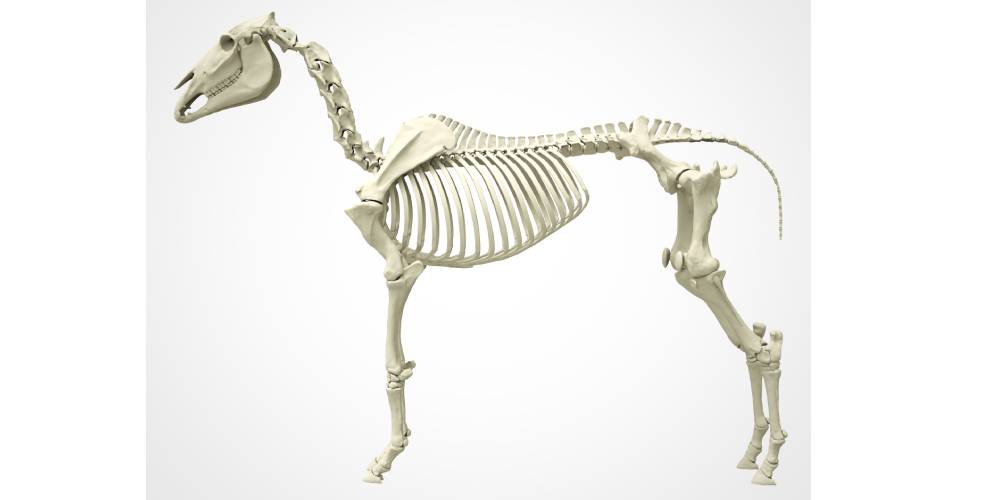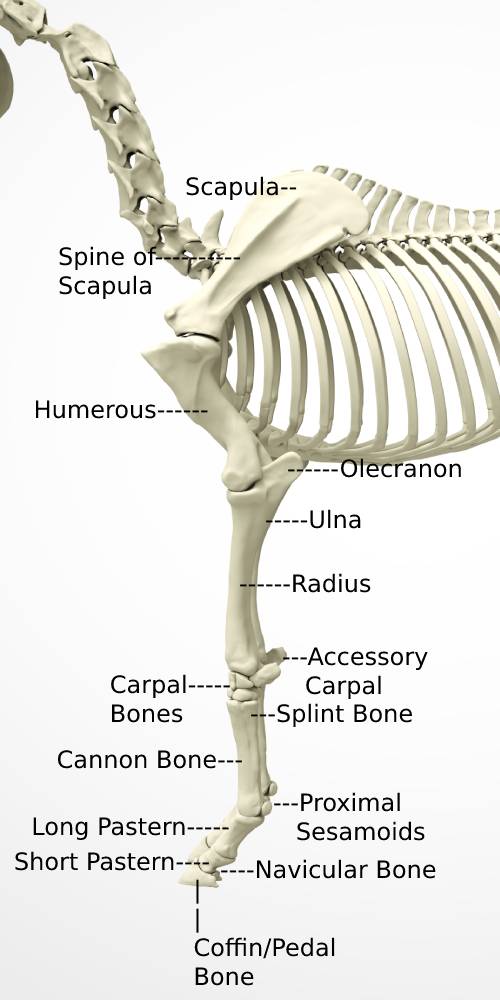The skeleton of the horse is a really complex structure that consists of around 205 different bones! Most of these bones can be found in the spine as vertebrae, but some of them lie elsewhere, like in the horse’s legs for example.
The Bones Of The Front Legs
There are so many different bones that make up the horse’s front legs and each of these bones was put there for a purpose. Like a machine runs, the bones of a horse’s body all work together to support and make the basic frame of the horse. The front legs of the horse are actually one of the most important parts of the horse’s skeleton as these legs alone carry 60% of the horse’s entire weight.

The Bones Of The Horse’s Front Legs:

Like I said above, I feel that it is best to break down the skeleton into different sections of the horse’s body to make it easier to understand. In this portion, I will talk to you about the bones of the horse’s front legs.
The front legs of a horse are unique and alone are made up of around 20 different bones. These bones include:
The Scapula
The scapula is a bone of the horse that makes up pretty much all of the horse’s shoulder. The scapula is a fairly large flat bone that moves whenever the horse takes a step forward. If you are posting the trot on a horse, you are looking at the movement of this bone to determine how you should post.
The Spine Of The Scapula
On the scapula bone, there is a raised ridge known as the spine of the scapula. This raised ridge on the horse’s scapula is there to basically split the surface of this bone in two to allow for easier or better muscle attachment.
The Humerus
Yes, just like people horses also have a funny bone. The unique thing about this bone is the fact that you can’t even really see it! The humerus bone is located just below the scapula where it is still considered a part of the horse’s shoulder. It is the attachment of this bone with the ulna and radius that actually makes up the horse’s elbow joint.
The Olecranon
The olecranon is a part of the horse’s leg that is attached to the ulna. The olecranon is part of what makes the horse’s elbow pointed as this bone is more pointed and sticks out as compared to the other bones in a horse’s body.
The Ulna
After the olecranon is identified, it should be pretty easy to tell what the ulna is as it is attached to the olecranon. The ulna is one of the bones that makes up the elbow joint.
The Radius
The radius in a horse’s leg is actually fused to the ulna bone. This makes it kind of hard to identify when looking at the bones of a horse, but because these bones are fused, you can still see an outline of which bone is which.
The Accessory Carpal Bone
In a horse’s knee, there are tons of small round bones that make up that joint. These bones are known as carpal bones. The accessory carpal bone is one of the carpal bones that is
The Carpal Bones
In humans, our carpal bones can be found in our wrist joint while in horses they can be found in the knee. In the horse’s knee alone there are around 8 different carpal bones. These bones are the:
- Radial Carpal Bone
- Intermediate Carpal Bone
- Ulnar Carpal Bone
- First Carpal Bone
- Second Carpal Bone
- Third Carpal Bone
- Fourth Carpal Bone
- Accessory Carpal Bone
The Splint Bone
Some horses, whether it is genetic or from stress to the leg, will grow something known as a splint bone. The splint bone will grow from the top of the cannon bone just below the knee and extend down a few inches on either side of the cannon bone acting as a kind of support or ‘splint.’
A large abnormally-shaped splint bone will be labeled as a blemish in the horse’s build and in a class judged on the horse’s conformation and health, they may be marked down for having this split bone.
The Cannon Bone
The cannon bone is one of the most familiar leg bones to people working with horses as it is this bone is where all leg wraps and boots are put and this is also the bone found just in front of the suspensory ligament and flexor tendon. The top part of the cannon bone meets up with the carpal bones at the knee and meets with the sesamoid bones and long pastern bone at the fetlock joint.
This bone is one of the most familiar and recognizable bones seen in the legs of horses.
The Proximal Sesamoid Bones
The proximal sesamoid bones are small bones found just above the rear of the fetlock joint. It was this bone that the famous racehorse Ruffian fractured in her final race. These bones are responsible for holding in place and supporting the suspensory apparatus so the fetlock and pastern joints can move properly. Without these bones, these joints couldn’t move properly and the horse would likely not be able to walk.
The Long Pastern Bone
The long pastern bone is the last bone to be considered a part of the horse’s leg before we start getting into the bones of the hoof (you can read about the bones of the hoof by clicking here). The long pastern bone meets the cannon bone at the joint known as the fetlock joint. The long pastern bone is attached not only to the cannon bone but to the short pastern bone found just inside the top of the hoof. This bone is involved in two of the most crucial joints for a horse’s movement, the fetlock joint and the pastern joint.
